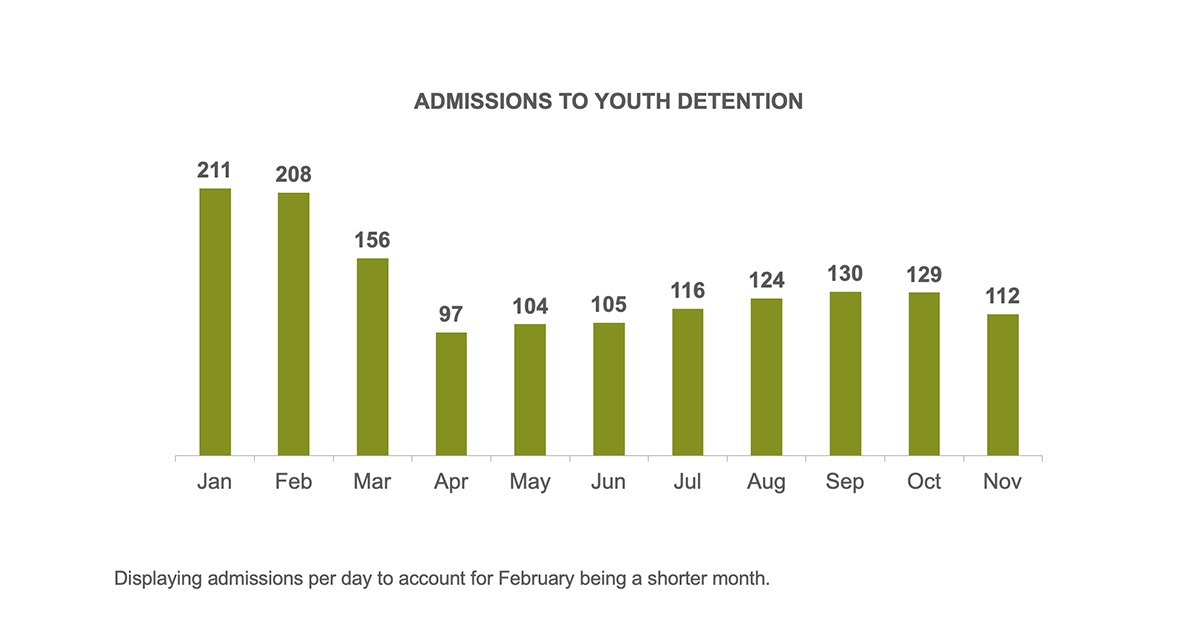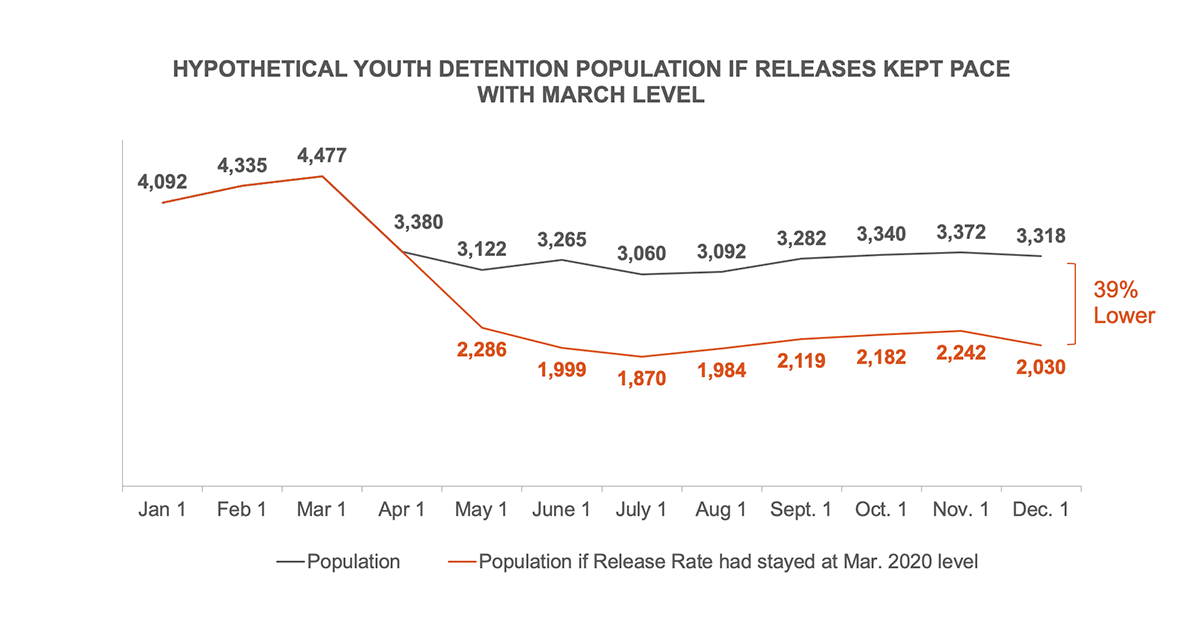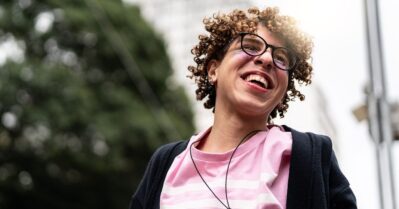Survey: More Youth in Secure Detention Despite Rise of COVID-19

A survey by the Annie E. Casey Foundation of youth justice agencies in 34 states finds COVID-19 cases surging in secure detention facilities in late 2020. More young people were held in juvenile detention on Dec. 1, 2020 — the most recent data available — than in the early months of the pandemic, and a greater share of those young people were Black and Latino, as a result of worsening disparities in how systems made decisions about detaining youth.
The survey, conducted each month since the pandemic began in March, is aimed at assessing the effects of the coronavirus pandemic on juvenile justice systems around the country, with some notable trends in the second half of 2020.
- Active COVID-19 cases among staff and youth in detention facilities more than doubled by mid-December to 168 cases for youth and 426 cases for staff — levels never seen before in this survey.
- Despite widespread knowledge of public health risks and early momentum to get youth out of detention and keep them out, the number of young people in detention grew by 8% in the second half of 2020, from July 1 to Dec. 1.
- During every month since April, the pace of releases from youth detention has been slower than before the pandemic. In fact, November’s pace set a six-month low.
- Black and Latino youth are lingering in detention even longer than white youth are.
“It’s unconscionable that young people are languishing in detention during a pandemic, and that there are clear patterns showing that Black and Latino youth are bearing the brunt of our lack of urgency in getting young people safely home,” said Nate Balis, director of the Foundation’s Juvenile Justice Strategy Group. “All young people deserve timely justice, especially as COVID-19 surges in facilities.”
Key Findings From the Juvenile Justice Survey
YOUTH AND STAFF AT HIGHEST RISK OF COVID-19 EVER
COVID-19 was more prevalent among youth and staff in detention facilities than at any point in the survey’s history.
By Dec. 15, active COVID-19 cases among staff and youth in detention facilities had doubled from the previous month for both youth and staff. For staff, the number jumped from 213 to 424 cases. For youth, the number jumped from 78 to 168 cases.
NUMBERS OF YOUNG PEOPLE IN DETENTION INCREASING COMPARED TO EARLY MONTHS OF THE PANDEMIC
After declining sharply in the early months of the pandemic, the population in youth detention increased in the second half of 2020, rising by 8% between July 1 and Dec. 1.
The size of the population is driven by two factors: the number of young people admitted to detention and how quickly they are released. Each trend is examined separately in the findings below.
Detention admissions fell more than 50% in the first two months of the pandemic. But rising admissions have erased over a quarter of those early gains.
Admissions to detention have been on an upward trajectory since April, with the exception of a 13% drop between October and November.
The pace of detention releases accelerated dramatically in March, but slowed in April and has lagged behind pre-pandemic levels every month since then.
“The pandemic has given justice systems every incentive to move cases faster and get young people sitting in detention home,” Balis said. “While the magnitude of the immediate response was encouraging, the urgency hasn’t been sustained and is actually getting worse.
One of every three youths in detention on Dec. 1 would not have remained confined had juvenile justice systems continued the higher rate of releases they processed early in the pandemic.
Had the release rate stayed at its high of 65% in March, more than one-third fewer young people would have been held in detention on December 1.
WORSENING RACIAL AND ETHNIC DISPARITIES IN YOUTH DETENTION
Over the course of the pandemic, Black and Latino youth are representing an increasingly larger share of the total detention population.
The racial and ethnic gap in population reductions that began to emerge in August persisted through Dec. 1. Compared with the pre-pandemic population on Mar. 1, the population on Dec. 1 was down 21% for Latino youth, 24% for Black youth and 33% for white youth.
Disparities in the detained population are getting worse because Black and Latino youth are staying in detention longer than they were before the pandemic and longer than white youth.
In fact, Black and Latino youth are slower to be released than their white peers (10% and 8% slower, respectively, in the month of November), and the gap favoring white youth has grown larger than it was before the pandemic began.
Had juvenile justice systems continued to release all youth as quickly as they released white youth in March, then there would have been 37% fewer white youth, 58% fewer Black youth and 55% fewer Latino youth in detention on Dec. 1.
“Releasing youth of color at the same rate as white youth would substantially reduce the detained population overall,” Balis said.
About the Survey
To understand the effects of the COVID-19 pandemic on youth detention populations, the Annie E. Casey Foundation has been surveying juvenile justice agencies across the country every month since April 2020 and reporting on youth detention trends. This survey is unique because it captures data in close to real time from a large group of jurisdictions that span all regions of the United States and range from large urban counties to small rural courts. In a typical month, the Foundation receives data from more than 150 jurisdictions in more than 30 states, containing more than 30% of the nation’s youth population (ages 10 to 17).
The latest results cover the period from January 1 to December 1, 2020 and are from a survey conducted between December 9, 2020 through January 21, 2021. Youth justice agencies in 34 states submitted responses. Responding sites collectively held 4,477 young people in secure detention on March 1, 2020. For perspective, nationally approximately 15,660 young people were held in detention on any given night, according to the most recent federal data from 2017.
Find a set of questions that can help juvenile justice leaders reduce youth detention











